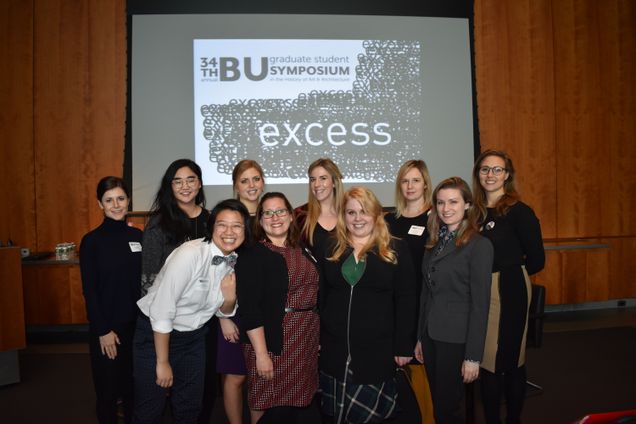Excess—The 34th Annual Boston University Graduate Student Symposium in the History of Art & Architecture

Excess – The 34thAnnual Boston University Graduate Student Symposium in the History of Art & Architecture, March 2–3, 2018.
This two-day event was generously sponsored by the Boston University Center for the Humanities; the Boston University Department of History of Art & Architecture; the Museum of Fine Arts, Boston; and the Boston University Art Gallery at the Stone Gallery.
What does it mean to be excessive? The 34thannual Boston University Graduate Student Symposium in the History of Art and Architecture called on graduate students to address art historical topics related to this very question. The theme of “Excess” inspired six presenters and our keynote speaker to explore the historically constructed idea of the extraneous, the leftover, or the superfluous, even that which is deemed peripheral or abject. The symposium began on March 2nd at the Boston University Art Gallery at the Stone Gallery with a keynote address by Dr. Cary Levine, Associate Professor of Contemporary Art at the University of North Carolina at Chapel Hill. Kicking off the opening evening of the symposium with zeal, Professor Levine took the audience on a discomfiting visual adventure into the unrestrained overconsumption of Paul McCarthy’s work. Examining what he calls the artist’s “food flinging frenzies,” Levine spoke to the deliberate excess that is McCarthy’s practice. The artist uses food and the politics of food to question the western construct of self-restraint by revealing the tension between individual moderation and overconsumption. Levine concluded by stressing that McCarthy’s performative works manifest in the impulsive, going so far as the perverse, to demonstrate imprisoned human vulgarity. This complicated overindulgence problematizes the vulnerability of our norms and forces us to ask what is normal, what is natural, and what is too much. Unsurprisingly, a lively question and answer session followed Professor Levine’s talk, inspiring both students and faculty to seek additional insights into the artist’s process, his audience, and his greater reception.
Professor Levine provided a fitting introduction to a stimulating symposium that featured six graduate student paper presentations at the Museum of Fine Arts, Boston on Saturday, March 3rd. Sasha Goldman, my co-coordinator, and I worked with discussants Alex Yen and Alison Terndrup to organize two sessions around themes of Excess. The morning session, entitled “Moreoverdone,” featured three papers that emphasized a careful scrutiny in assessing overindulgence and luxury. In her paper, Luxuria in the Shadow of Vesuvius: Personal Decoration as a Means of Constructing Feminine Personae at Oplontis, Kearstin Jacobson (Montana State University) started off our morning session by examining extravagant Roman jewelry from Campania and the difficult task of unpacking meaning through various moral and historical lenses. Caroline Murphy (MIT) introduced us to the seventeenth-century need to explain and legitimize seemingly extraneous pagan imagery as Christian iconography in her paper, Taming Excess: Antonio Bosio’s Roma Sotterranea(1632) and the Problematic Evidence of Catacomb Paintings in Counter-Reformation Rome. The paper examined the first historical publication that documented Christian paintings in the Roman catacombs and revealed the convoluted lengths to which the author ventured to fit these images into the strict tenets of the Counter-Reformation. Anna Ficek (CUNY) closed the morning session with her paper, Artifice and Excess in Urban Images: Picturing the Decline of Potosi in the Eighteenth Century.Through an examination of extraordinarily detailed paintings, this paper revealed the problematic omission of adversity suffered by the local population in eighteenth-century Potosi in favor of crafting a history of pomp and excess in line with the elite’s political agenda.
After a break for lunch, the symposium continued with an afternoon session entitled “More-nament” which focused on themes of excess related to group identity and the idea of overindulgence in relation to the quotidian. In her paper, Gilding the Grave: The Lavish Aesthetics of Death in a Picturesque Cemetery, Noël Albertsen (University of California, Davis) explored the extravagant aesthetics of Victorian monuments in a picturesque cemetery in Sacramento, California. The sublime quality of this resting place, inspired by nineteenth-century Parisian cemeteries, resulted in a romantic urban atmosphere of heightened emotion and deep mourning. Amanda Lett (Boston University) led us through the intricacies of nineteenth-century American bank note imagery in her paper, Too Handsome for Use: Bank Note Vignettes in the Antebellum Era. Reliant on imagery engraved on paper money as a way to convey trust, banks saturated their notes with agrarian and allegorical figures that became so overdone and overproduced that they essentially lost their meaning. Finishing out the afternoon session was Ashley Duffey (Pennsylvania State University) and her paper on a series of photographs by Robert Rauschenberg entitled, Glut on the Market: Robert Rauschenberg’s ‘Rome Flea Market’ and Post-War Italy. By focusing on Rauschenberg’s experience in Italy during the post-war period, this paper argued that the artist perceived the flea market photographs he took as capturing the extraordinary, resulting in an intentional blurring between simple tourist pictures and a complex American-Italian consumer relationship under the Marshall Plan.
The keynote lecture and all six graduate papers demonstrated how the theme of excess is a construct begging to be upended and reexamined. From overindulgence and luxury, to the abject and perverse, the art history of excess proves Oscar Wilde may have been right when he said, “moderation is a fatal thing. Nothing succeeds like excess.”